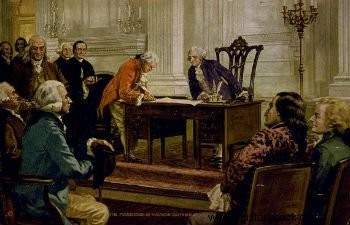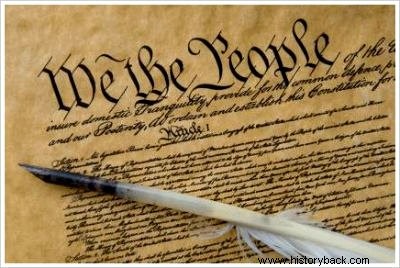The American Constitution it was enacted in 1787 and ratified two years later by the 13 American states.
In 1791, the American Magna Carta would receive the addition of the Bill of Rights (Bill of Rights ).
Origin

"The Foundation of the American State", by Henry Hintermeister, 1925.
After the declaration of independence of the 13 colonies from England, the American states adopted the Confederate regime. Although there was a central government, it allowed each state to be autonomous from its neighbors in political and legal terms.
Read more about the Independence of the United States.
However, the fear that there would be a British invasion or that a civil war would start between the states, made the representatives of each one meet in the city of Philadelphia. There, they discussed various proposals that would result in the political system that would give rise to the United States.
Twelve of the 13 states – except Rhode Island – were represented at the Constitutional Convention through 55 delegates.
Proposals
The delegates' main concern was to seek a balance between centralizing power in the hands of a president and maintaining the autonomy of states. Likewise, the Executive Power should be constrained by laws that prevent it from turning the government into a tyranny.
The debate was thus divided between Federalists and Anti-Federalists.
The Federalists were merchants who lived in large cities. They believed that a central government should have enough authority to collect taxes and maintain peace between states.
In turn, anti-federalists feared that a strong government would not respect the individual rights of citizens. They were formed by landowners, who didn't want to pay taxes to a government that was far away and didn't care about them.
The Federalists, after all, imposed their ideas, but promised that they would add a Bill of Rights to the Constitution once the new government was constituted.
The Constitution has been ratified by 11 states. Only North Carolina and Rhode Island did not initially, but in the end, they also accepted.
Features of the United States Constitution
The United States Constitution was the first in the world to use the word “people” in its preamble:
Thus it was clear that the power emanated from the people and not from God or the King. Below, the original of the US Constitution.

First Articles of the United States Constitution.
Main Articles
- It determined that the form of government was a federal presidential republic. Power would be divided into Executive, Legislative and Judiciary,
- unified the monetary and measurement system that would be used,
- states should respect the individual rights of citizens,
- established the bicameral system:Congress of Deputies and Senate,
- The Supreme Court was created,
- the Head of State and Government would be elected by free citizens, through the Electoral College.
Bill of Rights )
The Bill of Rights it was added to the US Constitution in 1791 in order to guarantee some basic rights to the common citizen.
In this way, the right to:
- Freedom of expression:every citizen has the right to freely express their ideas,
- practice your religion freely,
- keep silent during a police interrogation,
- include additions (amendments) to the Constitution when necessary.
Delicate Theme:Slavery
Despite many state delegates acknowledging that slavery was immoral, discussions on abolition did not prosper, in order not to upset representatives from southern states.
This would increasingly deepen the differences between North and South that would culminate in the Civil War.
Curiosities
- It is the second constitution in force in the world, second only to that of the Republic of San Marino, of 1600.
- In its 230 years of existence, the US Constitution has received 27 amendments.
- For this reason, it is considered the smallest written Constitution in the world:it has seven articles and 27 amendments that fit into five pages.
- The preamble to the American Constitution was set to music and is in the American collegiate repertoire. There are several versions of the song.
We have more texts on the subject for you:
- George Washington
- Benjamin Franklin
- Social Contract
- The Thirteen Colonies and the Formation of the United States
- Death Penalty
